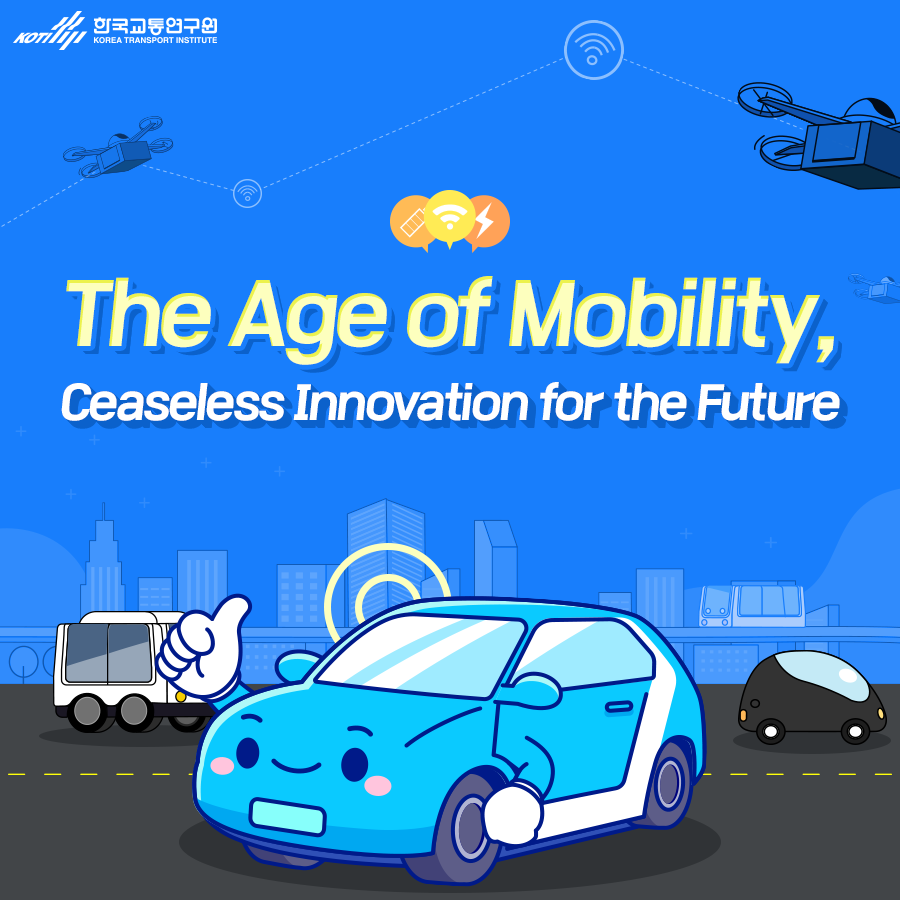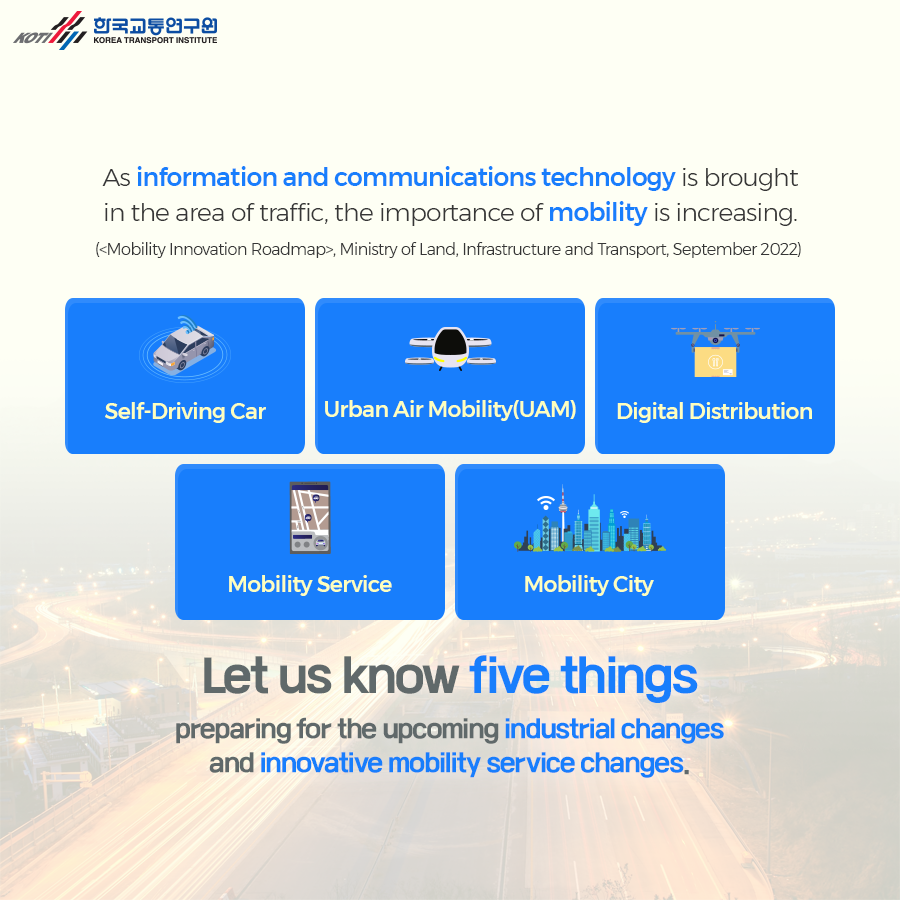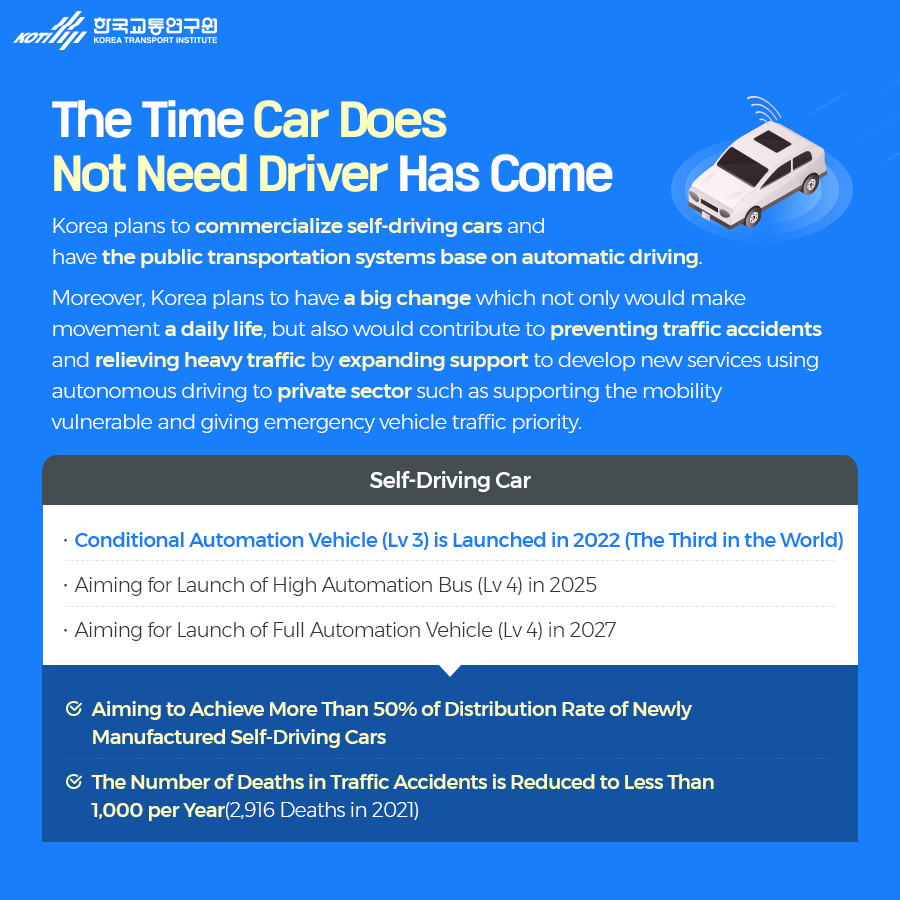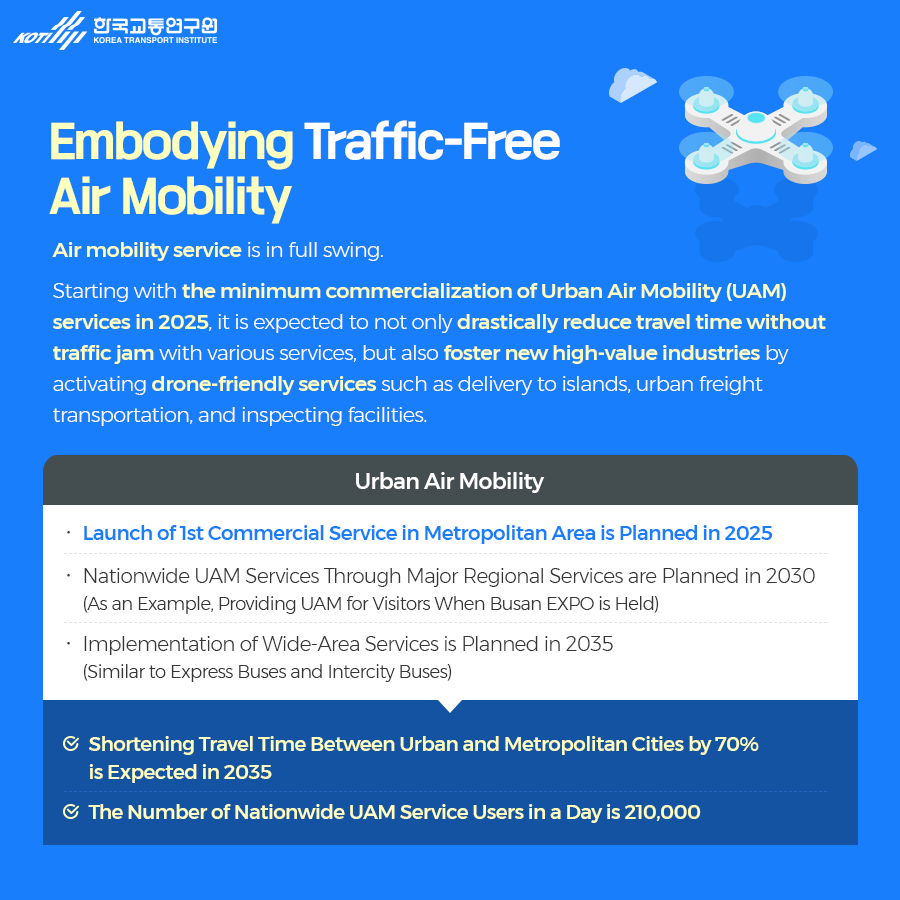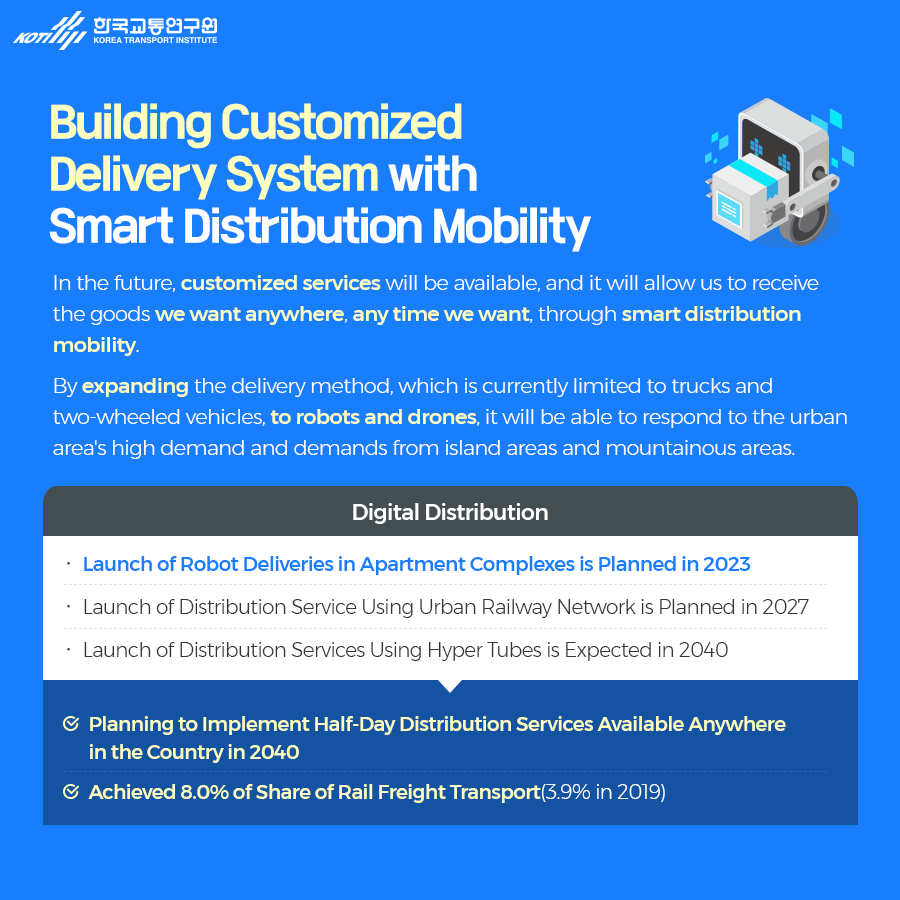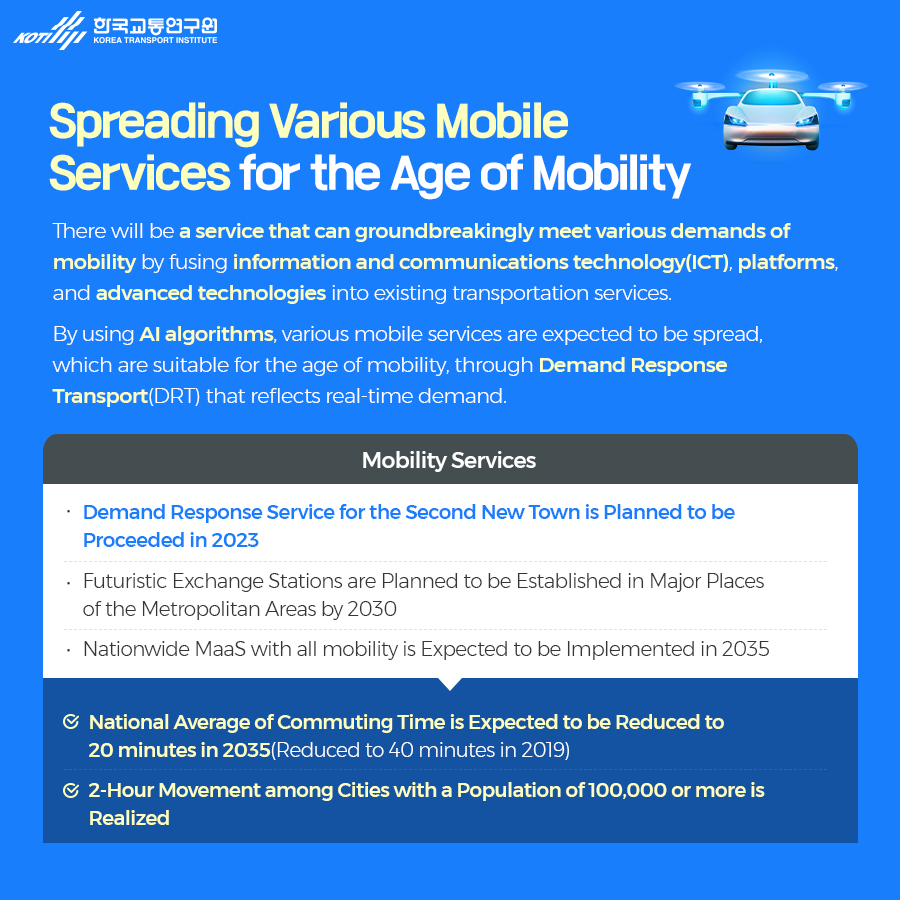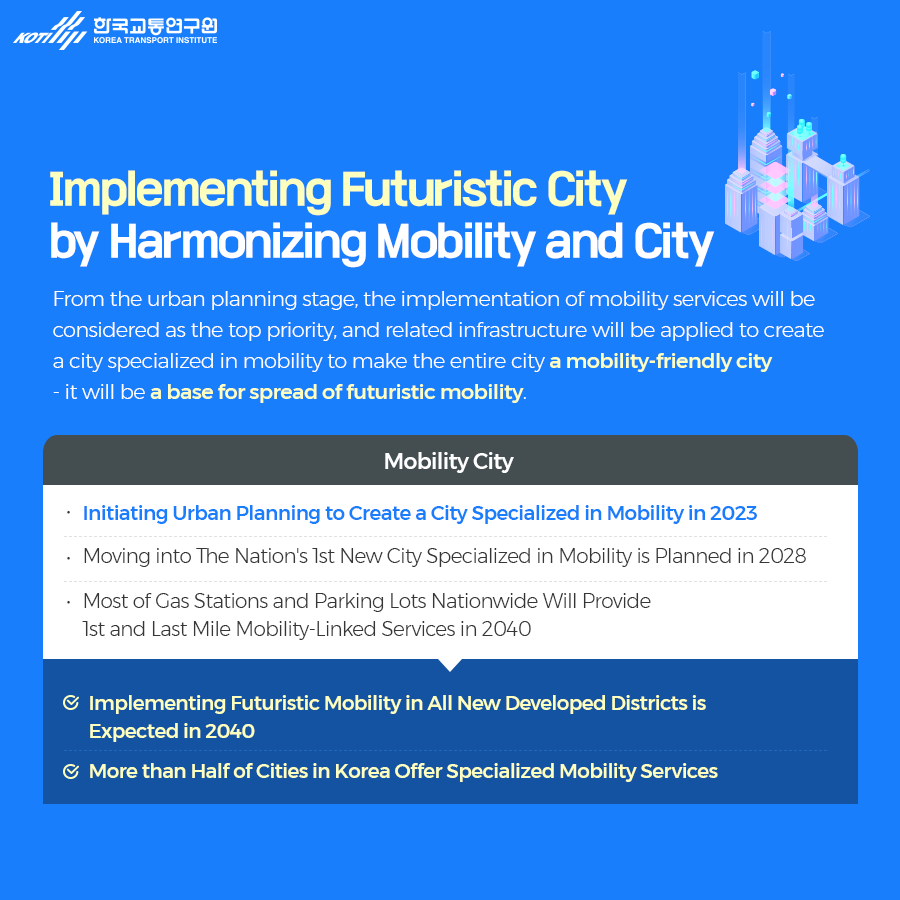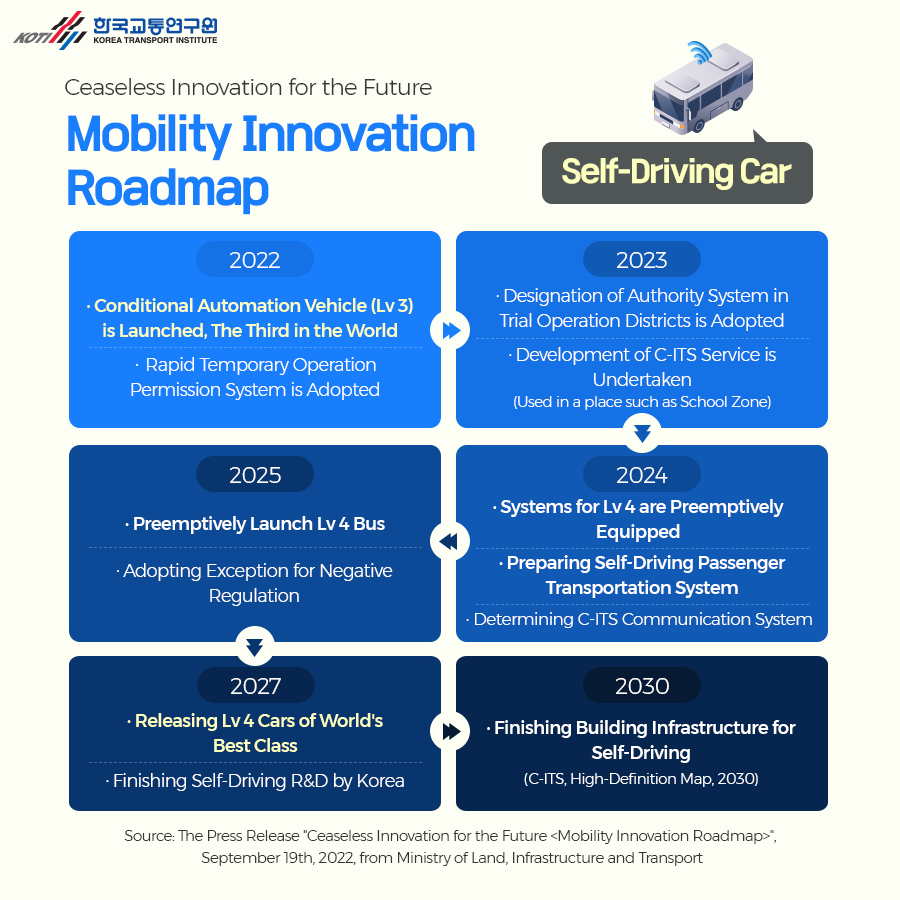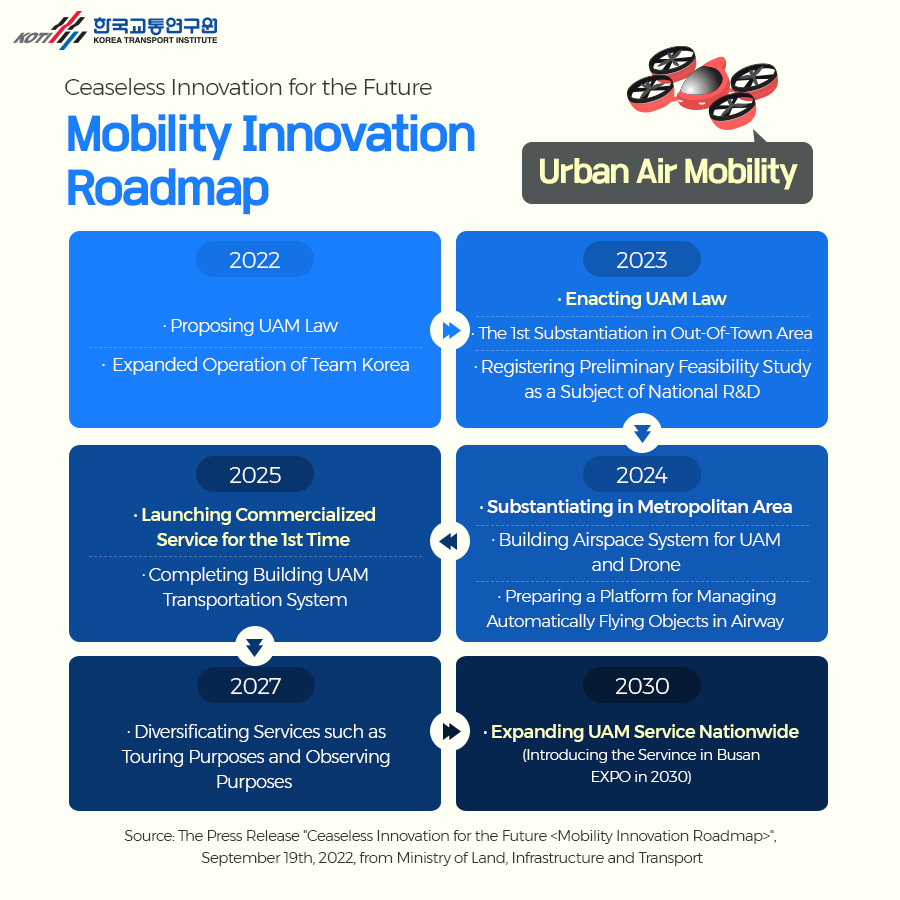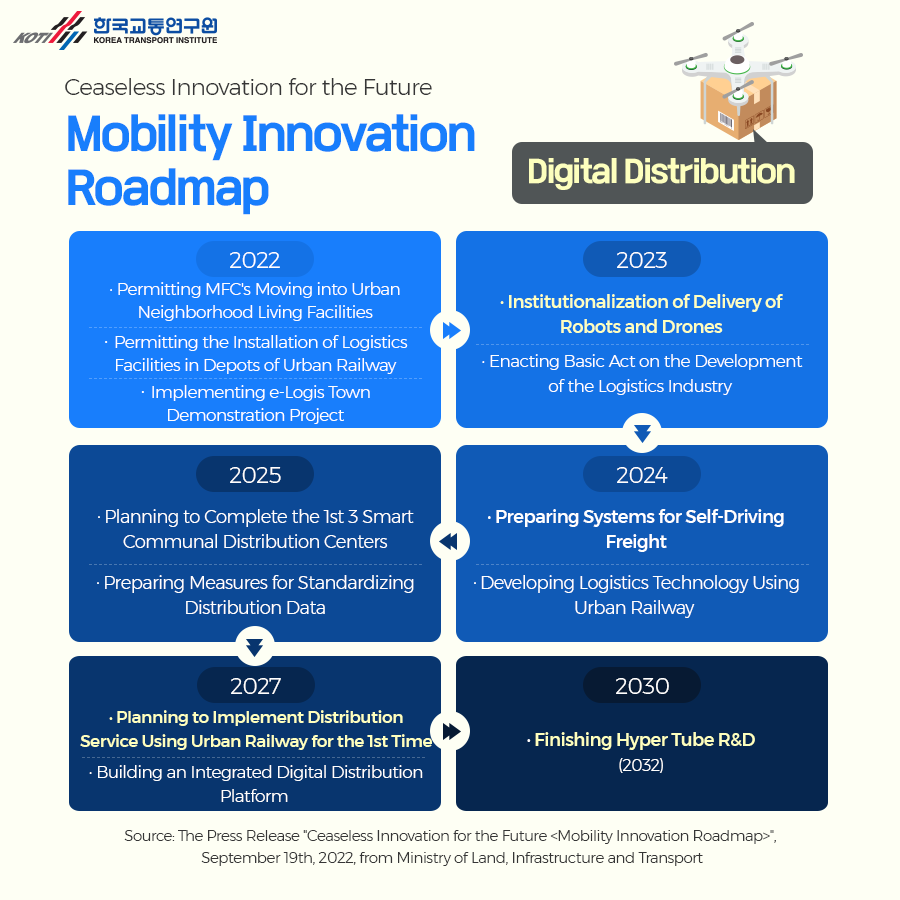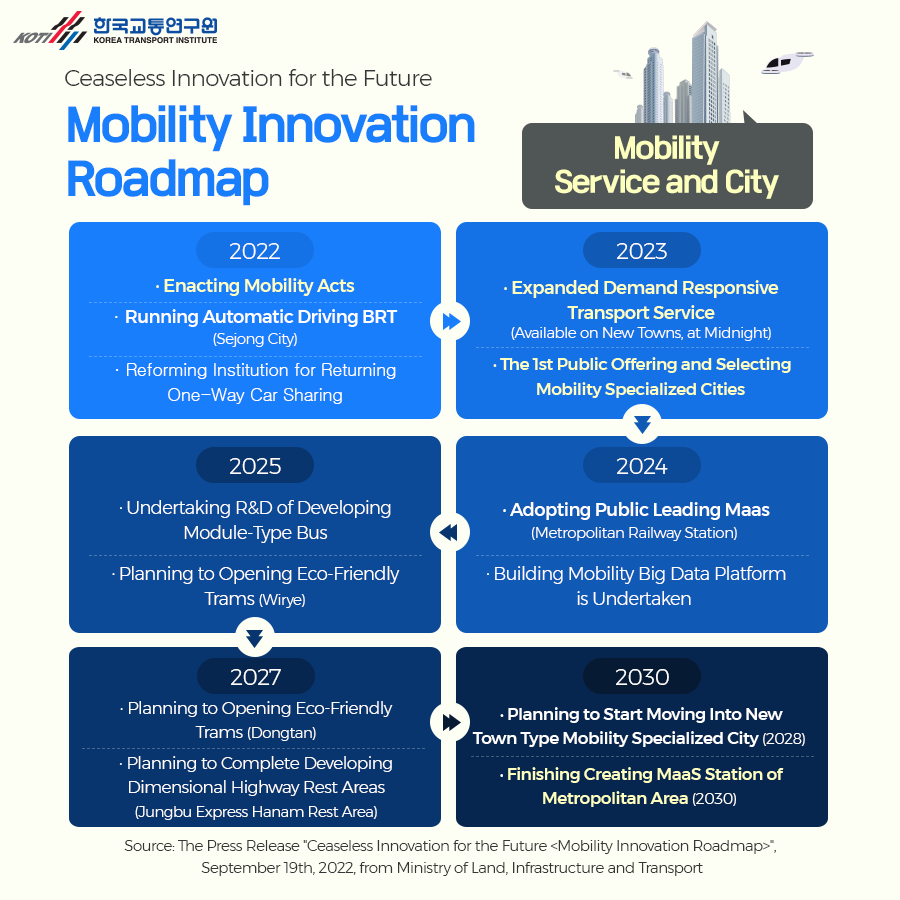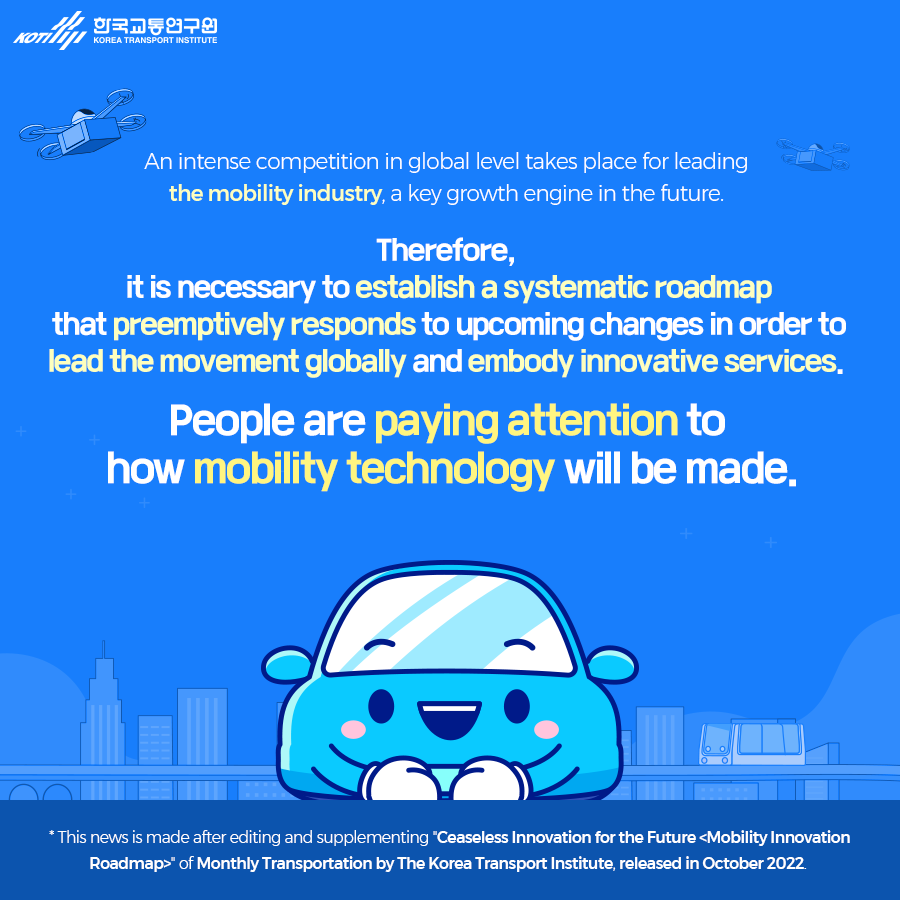Card News

NEWS
KOTI - Korea Transport institute-
# As information and communications technology is brought in the area of traffic, the importance of mobility is increasing. (
, Ministry of Land, Infrastructure and Transport, September 2022)
Let us know five things preparing for the upcoming industrial changes and innovative mobility service changes.
Self-Driving Car / Urban Air Mobility / Digital Distribution / Mobility Service / Mobility City
# The Time Car Does Not Need Driver Has Come
Korea plans to commercialize self-driving cars and have the public transportation systems base on automatic driving.
Moreover, Korea plans to have a big change which not only would make movement a daily life, but also would contribute to preventing traffic accidents and relieving heavy traffic by expanding support to develop new services using autonomous driving to private sector such as supporting the mobility vulnerable and giving emergency vehicle traffic priority.
Self-Driving Car / Conditional Automation Vehicle (Lv 3) is Launched in 2022 (The Third in the World) / Aiming for Launch of High Automation Bus (Lv 4) in 2025 / Aiming for Launch of Full Automation Vehicle (Lv 5) in 2027 / Aiming to Achieve More Than 50% of Distribution Rate of Newly Manufactured Self-Driving Cars / The Number of Deaths in Traffic Accidents is Reduced to Less Than 1,000 per Year (2,916 Deaths in 2021)
# Embodying Traffic-Free Air Mobility
Air mobility service is in full swing.
Starting with the minimum commercialization of Urban Air Mobility (UAM) services in 2025, it is expected to not only drastically reduce travel time without traffic jam with various services, but also foster new high-value industries by activating drone-friendly services such as delivery to islands, urban freight transportation, and inspecting facilities.
Urban Air Mobility / Launch of 1st Commercial Service in Metropolitan Area is Planned in 2025 / Nationwide UAM Services Through Major Regional Services are Planned in 2030 (As an Example, Providing UAM for Visitors When Busan EXPO is Held) / Implementation of Wide-Area Services is Planned in 2035 (Similar to Express Buses and Intercity Buses) / Shortening Travel Time Between Urban and Metropolitan Cities by 70% is Expected in 2035 / The Number of Nationwide UAM Service Users in a Day is 210,000
# Building Customized Delivery System with Smart Distribution Mobility
In the future, customized services will be available, and it will allow us to receive the goods we want anywhere, any time we want, through smart distribution mobility.
By expanding the delivery method, which is currently limited to trucks and two-wheeled vehicles, to robots and drones, it will be able to respond to the urban area's high demand and demands from island areas and mountainous areas.
Digital Distribution / Launch of Robot Deliveries in Apartment Complexes is Planned in 2023 / Launch of Distribution Service Using Urban Railway Network is Planned in 2027 / Launch of Distribution Services Using Hyper Tubes is Expected in 2040 / Planning to Implement Half-Day Distribution Services Available Anywhere in the Country in 2040 / Achieved 8.0% of Share of Rail Freight Transport (3.9% in 2019)
# Spreading Various Mobile Services for the Age of Mobility
There will be a service that can groundbreakingly meet various demands of mobility by fusing information and communications technology (ICT), platforms, and advanced technologies into existing transportation services.
By using AI algorithms, various mobile services are expected to be spread, which are suitable for the age of mobility, through Demand Response Transport (DRT) that reflects real-time demand.
Mobility Services / Demand Response Service for the Second New Town is Planned to be Proceeded in 2023 / Futuristic Exchange Stations are Planned to be Established in Major Places of the Metropolitan Areas by 2030 / Nationwide MaaS with all mobility is Expected to be Implemented in 2035 / National Average of Commuting Time is Expected to be Reduced to 20 minutes in 2035 (Reduced to 40 minutes in 2019) / 2-Hour Movement among Cities with a Population of 100,000 or more is Realized
# Implementing Futuristic City by Harmonizing Mobility and City
From the urban planning stage, the implementation of mobility services will be considered as the top priority, and related infrastructure will be applied to create a city specialized in mobility to make the entire city a mobility-friendly city -- it will be a base for spread of futuristic mobility.
Mobility City / Initiating Urban Planning to Create a City Specialized in Mobility in 2023 / Moving into The Nation's 1st New City Specialized in Mobility is Planned in 2028 / Most of Gas Stations and Parking Lots Nationwide Will Provide 1st and Last Mile Mobility-Linked Services in 2040 / Implementing Futuristic Mobility in All New Developed Districts is Expected in 2040 / More than Half of Cities in Korea Offer Specialized Mobility Services
# Ceaseless Innovation for the Future / Mobility Innovation Roadmap
(Self-Driving Car) 2022: Conditional Automation Vehicle (Lv 3) is Launched, The Third in the World / Rapid Temporary Operation Permission System is Adopted
2023: Designation of Authority System in Trial Operation Districts is Adopted / Development of C-ITS Service is Undertaken (Used in a place such as School Zone)
2024: Systems for Lv 4 are Preemptively Equipped / Preparing Self-Driving Passenger Transportation System / Determining C-ITS Communication System
2025: Preemptively Launch Lv 4 Bus / Adopting Exception for Negative Regulation
2027: Releasing Lv 4 Cars of World's Best Class / Finishing Self-Driving R&D by Korea
2030: Finishing Building Infrastructure for Self-Driving (C-ITS, High-Definition Map, 2030)
# (Urban Air Mobility) 2022: Proposing UAM Law / Expanded Operation of Team Korea
2023: Enacting UAM Law / The 1st Substantiation in Out-Of-Town Area / Registering Preliminary Feasibility Study as a Subject of National R&D
2024: Substantiating in Metropolitan Area / Building Airspace System for UAM and Drone / Preparing a Platform for Managing Automatically Flying Objects in Airway
2025: Launching Commercialized Service for the 1st Time / Completing Building UAM Transportation System
2027: Diversificating Services such as Touring Purposes and Observing Purposes
2030: Expanding UAM Service Nationwide (Introducing the Servince in Busan EXPO in 2030)
# (Digital Distribution) 2022: Permitting MFC's Moving into Urban Neighborhood Living Facilities / Permitting the Installation of Logistics Facilities in Depots of Urban Railway / Implementing e-Logis Town Demonstration Project
2023: Institutionalization of Delivery of Robots and Drones / Enacting Basic Act on the Development of the Logistics Industry
2024: Preparing Systems for Self-Driving Freight / Developing Logistics Technology Using Urban Railway
2025: Planning to Complete the 1st 3 Smart Communal Distribution Centers / Preparing Measures for Standardizing Distribution Data
2027: Planning to Implement Distribution Service Using Urban Railway for the 1st Time / Building an Integrated Digital Distribution Platform
2030: Finishing Hyper Tube R&D
# (Mobility Service and City) 2022: Enacting Mobility Acts / Running Automatic Driving BRT (Sejong City) / Reforming Institution for Returning One-Way Car Sharing
2023: Expanded Demand Responsive Transport Service (Available on New Towns, at Midnight) / The 1st Public Offering and Selecting Mobility Specialized Cities
2024: Adopting Public Leading Maas (Metropolitan Railway Station) / Building Mobility Big Data Platform is Undertaken
2025: Undertaking R&D of Developing Module-Type Bus / Planning to Opening Eco-Friendly Trams (Wirye)
2027: Planning to Opening Eco-Friendly Trams (Dongtan) / Planning to Complete Developing Dimensional Highway Rest Areas (Jungbu Express Hanam Rest Area)
2030: Planning to Start Moving Into New Town Type Mobility Specialized City (2028) / Finishing Creating MaaS Station of Metropolitan Area (2030)
Source: The Press Release "Ceaseless Innovation for the Future
", September 19th, 2022, from Ministry of Land, Infrastructure and Transport
# An intense competition in global level takes place for leading the mobility industry, a key growth engine in the future.
Therefore, it is necessary to establish a systematic roadmap that preemptively responds to upcoming changes in order to lead the movement globally and embody innovative services.
People are paying attention to how mobility technology will be made.
* This news is made after editing and supplementing "Ceaseless Innovation for the Future
" of Monthly Transportation by The Korea Transport Institute, released in October 2022.
